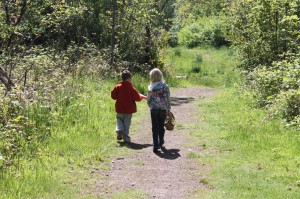 Recently, each of my kids has made a comment about family rules lately that made me realize: we don’t have any. Well, nothing formal anyway.
Recently, each of my kids has made a comment about family rules lately that made me realize: we don’t have any. Well, nothing formal anyway.
Not to give you the impression that our home is a chaotic free-for-all, devoid of any kind of morality. I like order and manners and helpful contributions as much as any parent. We just do not have a concrete list of rules that that govern our family–a list of dos and don’ts–and I have never once spoken the words, “That’s the rule.”
I didn’t even realize this until one day we were playing the game of If and a question read, If you could get rid of one rule in your house, what would it be? For a minute, no one answered. I thought my kids were simply trying to narrow their answers down. But then my 7-year old daughter said, “Ummm…we don’t have any rules.”
We don’t? Do we not get done what needs to get done every day? Do we not aim to treat each other kindly? To respect our ourselves, each other, our friends, elders, teachers, and our personal property? Do we really not articulate that these are important practices by which to live? How is it, then, that we do them anyway, and more importantly that our kids internalize these values–without stated rules?
Maybe our family rules are more like principles that are felt and understood than declared. Maybe we have rules, but they’re not “Rules.” Maybe our rules have never been formalized because they are lived.
Upon returning from a playdate one day, my 6-year-old son, JJ, had this to say:
JJ: I had a good time, but the one thing I don’t like about my friend’s house is that they have rules.
Me: Rules?
JJ: Yeah, they have rules that you can’t do certain stuff or that you have to do other stuff! They always say, “Well, that’s our rule.”
Me: And we don’t have rules?
JJ: No! We just do what needs to be done. But it’s not a rule. We just know.
And oh, how I love that our kids just know.
To be clear, I get rules. I don’t have anything against them, especially the more people that exist in an environment. Rules keep people safe. They create organization and regulation and ensure fairness. Our kids also understand them. They follow rules where rules exist. They just prefer not to be “ruled.”
 Rules provide external guidance and structure, much like a trellis that holds up a viney plant; the trellis directs the plant which way to grow. Without it, the plant falls to the ground; it doesn’t have adequate internal strength to grow taller than the structure provided. On the other hand, there are trees that reach truly exceptional heights because the structure is built from within. (And the roots are deeply secure!) The sturdier the internal structure and the more secure the roots, the greater the capacity for growth.
Rules provide external guidance and structure, much like a trellis that holds up a viney plant; the trellis directs the plant which way to grow. Without it, the plant falls to the ground; it doesn’t have adequate internal strength to grow taller than the structure provided. On the other hand, there are trees that reach truly exceptional heights because the structure is built from within. (And the roots are deeply secure!) The sturdier the internal structure and the more secure the roots, the greater the capacity for growth.
People also have this capacity for strength and security. And we can begin to develop it in our children’s youth, not by structuring their growth around an externally imposed set of rules, but by fostering their strength from the inside out.
We teach our kids to live the rules, not follow the rules. To just know: Do what needs to be done.
So how does our family set boundaries with no rules? How do we live the rules instead of administer the rules? How do our kids learn about behavior without a set of rules to follow?
We live by example. Instead of having a rule that we don’t hit each other, we don’t hit each other. Instead of having a rule that everyone must share, we are thoughtful and generous with our possessions. Instead of having a rule to say please and thank you, we say please and thank you. Our actions are authentic, not driven by rules.
We connect before we correct. Mostly, I mean an ongoing, long-term connection–we strive for a close, loving, respectful relationship between ourselves and our kids, and this is what guides any behavior corrections. Children are apt to follow the lead of someone to whom they are emotionally connected.
We give directions as we go. If our kids are doing something that needs to stop, we ask them to stop. And they stop.
We are kind and firm. Our kids know that we understand where their behavior is coming from (kindness in empathy), and the answer is no (firmness). “I know you enjoy the fun of jumping on the couch…but please don’t.”
We problem solve. If a behavior happens one time or over and over and over again, we don’t institute a rule and an impending consequence, we get to the root of what is going on and brainstorm ways to solve the problem to change the behavior.
We have family meetings. We regularly discuss behaviors and habits in the house and collaboratively decide what do about them.
We look for the need behind the behavior. “Rule-breaking behavior” is not just behavior that breaks a rule. There’s more to it–a need that a child is trying to meet (though inappropriately). Instead of making a rule to stop the behavior, our approach is to meet the need to stop the behavior.
We follow rules where rules exist. Pretty much any type of activity, class, camp, event, or kid-centered business has a concrete set of dos and don’ts for participants. If we want to take part, we do what the organization deems necessary to be safe and respectful. Wait in line? Take off your shoes? Go one at a time? Don’t touch the equipment? Clean up your work area? No running? Must be a certain age to ride? We understand why rules exist in the world.
At home, we just live in a way that we don’t let rules get in the way of our relationship.


I’m not a fan of rules myself, at least not arbitrary ones. I can totally relate to your kids – I HATED visiting friends whose parents had ridiculous rules that seemed to serve no real purpose other than control. I refused to spend the night at my cousins’ because we had to get up at the crack of dawn on the weekends to do chores! Why oh why couldn’t those chores be done in the afternoon, especially when there are guests over? It still bothers me – I remember feeling so powerless, and I suspect that was the point. Kudos to you for instilling values and a sense of responsibility without a rule sheet!